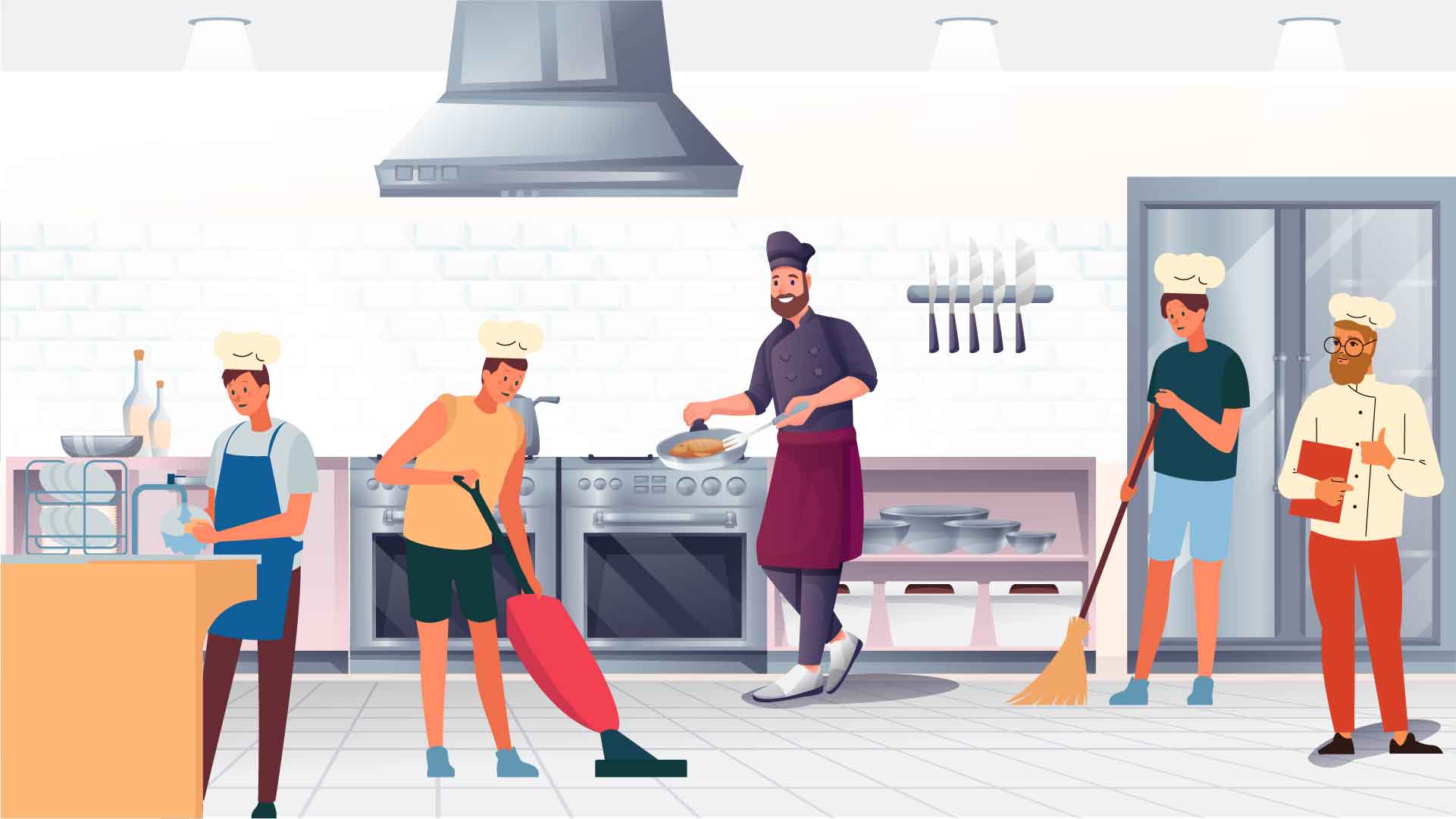10 Golden Rules of Kitchen Hygiene Every Chef Should Know

Hygiene is the base of success in food industry. A lot is at sake when it comes to reputed chains of restaurants including the customer base and their reputation. The foundation of food safety lies in maintaining exceptional personal cleanliness and keeping the kitchen ultra clean. Whether you’re a seasoned chef or a budding culinary enthusiast, understanding and adhering to the golden rules of kitchen hygiene is non-negotiable. Beneath are the top 10 basic kitchen hygiene rules to maintain the cleanliness standards expected from the professional chefs:

-
- Personal Hygiene: The First Line of Defence
It all begins with the basics- keeping your self clean is utmost important to keep the surroundings clean. Personal hygiene for kitchen staff can be maintained with a few simple rules. Wearing clean attire, including hats, aprons, and gloves when necessary, is a must. Wash hands on regular intervals and avoid touching your face, hair, or any surfaces while handling food to prevent contamination. - Food Separation: Keeping Contamination at Bay
Cross-contamination of food is the worst nightmare of any kitchen manager. To prevent this, always separate raw meats, seafood, poultry, and their juices from ready-to-eat foods. Use separate cutting boards, utensils, and storage areas to minimize the risk of harmful pathogens spreading. - Food Storage: The Cool and Controlled Heaven
You can easily guard against early spoilage and contamination with proper food storage practices. Frozen food should be kept at 0°F and the food liable to easily rot should be stored at or below 40°F. Labelling and dating the items for a systematic rotation will help you ensure that the older products are used before newer ones. - Maintain Right Cooking Temperatures: Cook the Threat Away
Cooking is a complete science. Ensuring that food reaches the correct required internal temperature is vital for killing harmful bacteria. For meats and other potentially hazardous foods, using a food thermometer is recommended to ensure food safety. - Clean and Sanitised Kitchen: Make it a Habit, not a Chore
Cleanliness is a virtue, specially when it comes to the kitchen. It is necessary to clean and sanitize all surfaces that come into contact with food including knives, utensils, cutting boards, stoves, storage areas and other tools, on daily basis. Setting up same time for kitchen cleanliness will help in making it a non-negotiable habit. This helps in maintaining a hygienic workspace and preventing the growth of harmful bacteria. - Proper Waste Disposal: Being Responsible is the Key
Proper waste disposal is not just environment friendly but in fact is a matter of food safety. It is important to dispose off the kitchen waste is sealed containers to prevent odours and pests from invading your kitchen. Create and follow waste disposal guidelines which resonates with your kitchen functioning to ensure proper waste disposal. - Pest Control: Keep the Uninvited Guests Away
Pests are the nasty visitors that can wreak havoc on your kitchen’s hygiene. Disposing off the waste properly, sealing any gaps in the walls, floors, windows and sinks, and keeping the kitchen clean can help you ward off the pests. Regular pest control activities can help you ensure you are not prone to have your kitchen intruded by unwanted pests. - Take Breaks when ill: Ethics and Safety go hand in hand
As a chef, your health can directly impact other’s health and therefore, showing up while sick can have dire consequences. If you are feeling sick, specially with symptoms of contamination like cold, nausea, other viral infections, avoid handling food an notify your supervisor. COVID has taught us well how prioritizing our health and keeping distance when sick, can help us in keeping our customers and colleagues safe. - Allergen Awareness: A Lifesaving Skill
Food allergies are a serious concern and can bring big issues to your work place when a customer falls sick after eating your food. Chefs must stay vigilant about allergen cross-contact and asking your customers about allergies to common allergens can be lifesaving. Educate yourself about common food allergens and implement measures to prevent cross-contamination between allergenic and non-allergen foods. - Separate Cooking Sections for Veg and Non-Veg: Respecting The Vegetarian Customer’s Concerns
Separating vegetarian and non-vegetarian food can be a hygienic practice that can help in ensuring vegetarian customers that there is no trace of non-vegetarian food in their plate. Following the Color coed system for cutting boards can be a great practice. You can utilize the green board exclusively for vegetables, reserve the red board solely for meat, assign the yellow board for chicken, and dedicate the white board solely to fish. This will help you achieve high standard for handling food well while keeping the kitchen clean.
Conclusion
In the culinary world, where flavours and aromas play important roles, kitchen hygiene stands as the unwavering foundation upon which great meals are built. As chefs, it’s our prime responsibility to ensure that our dishes not only tantalize the taste buds but also uphold the highest standards of safety and cleanliness. So, whether you’re crafting a delicate soufflé or searing a succulent steak, remember: these GOLDEN RULES are your steadfast companions to culinary mastery
- Personal Hygiene: The First Line of Defence